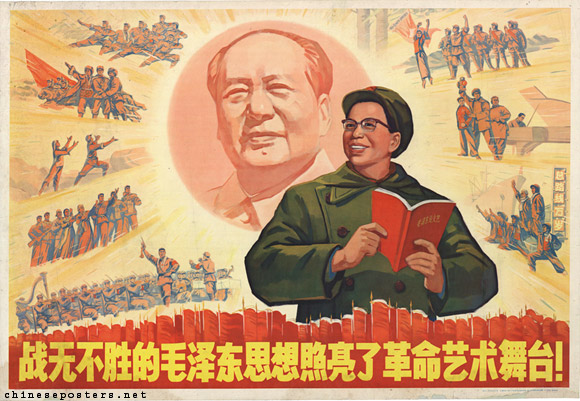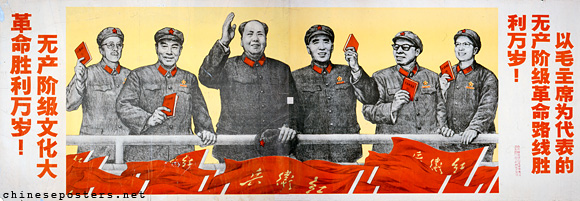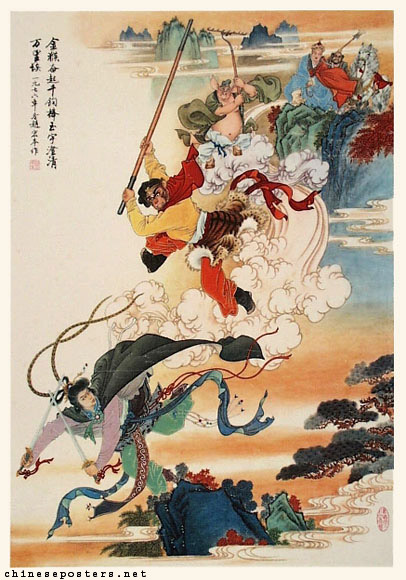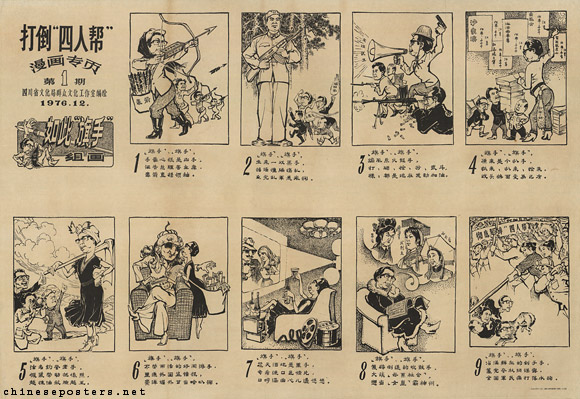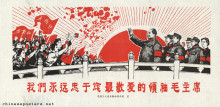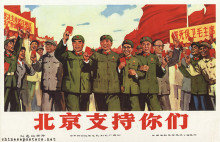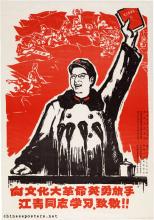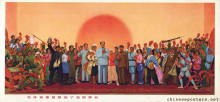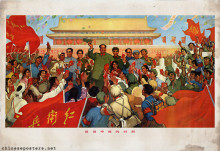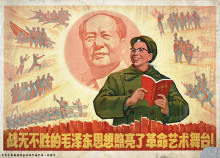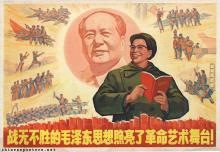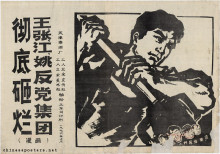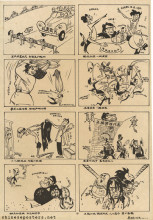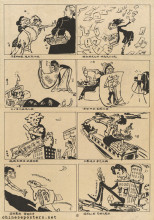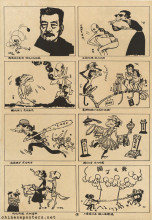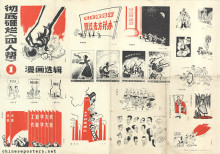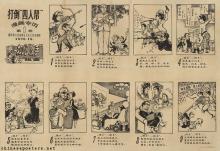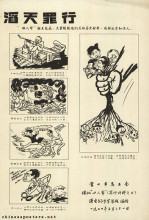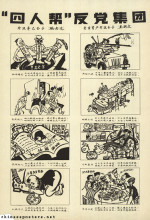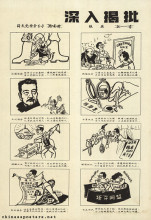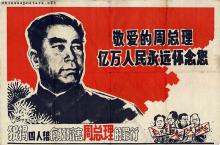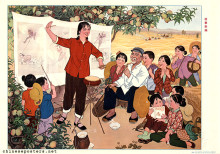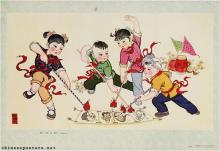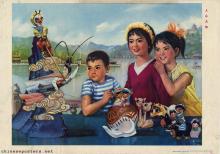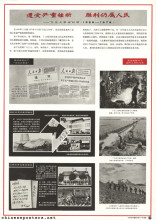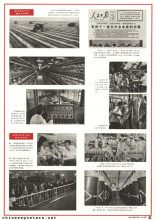The invincible Mao Zedong Thought illuminates the stage of revolutionary art!, 1969
Jiang Qing (江青, 1913-1991) was born as Li Yunhe in Zhucheng, Shandong Province. As Lan Ping (Blue Apple), she became a moderately successful actress in Shanghai in the years 1934-1937. Her close friend - some say secret lover - Kang Sheng introduced her to Mao Zedong in Yan'an. Despite the fact that Mao was still married at the time to He Zizhen, Lan Ping, now called Jiang Qing, became his wife in 1939. The Party leadership continued to support He and stongly objected to the marriage. Eventually, a compromise was found on the condition that Jiang would restrict herself to the role of housewife and would refrain from playing any role in politics. She served as Mao's personal secretary in the 1940s and was head of the Film Section of the CCP Propaganda Department in the 1950s. In the early 1960s, however, she sided with Lin Biao, and both made a bid for power.
In the opening years of the Cultural Revolution (1966-1976), Jiang merely dominated the Chinese arts, in particular through her attempts to reform the Beijing Opera through her 'model operas' (样板戏, yangbanxi). She was supported by a radical coterie, dubbed the 'Gang of Four' by Mao himself. Although a prominent member of the Central Cultural Revolution Group and a major player in Chinese politics in the period 1966-1976, relatively few posters have been published which show her in action.
Later on, she played an increasingly active political role in the movement, taking part in all important Party and government activities. As an indication of her influence, she even succeeded in selecting her own model for emulation in 1974: the village of Xiaojinzhuang, near Tianjin. Here, a utopian vision of rural China was enacted that focused more on poetry-writing and opera-singing than on hard production targets. Moreover, the female inhabitants were supposed to wear the very impractical Jiang Qing dress (Jiang Qing fu), the clothing Jiang had designed herself.
Monkey thrice beats the White Bone Demon, 1977
When Mao died in 1976, Jiang lost the support and major source of justification for her political activities. Hua Guofeng arrested her and the other members of the Gang of Four. I personally always thought that the poster 'Monkey thrice beats the White Bone Demon', designed in 1976 and published a year later, was an allegorical way of showing the defeat of Jiang. Monkey (Sun Wukong), the hero of the popular Ming-dynasty novel Journey to the West, stood for the Chinese people, and the White Bone Demon, a devil of the first order, was Jiang Qing. However, when I proposed this theory to veteran designers Ha Qiongwen and Qian Daxin (formerly of the Shanghai People's Arts Publishing House), they were very amused, but insisted this was not the case.
Down with the "Gang of Four" single sheet cartoons, no. 1, 1976
In January 1981, Jiang was sentenced to death with a two-year reprieve and permanent deprivation of her political rights. The sentence was commuted to life imprisonment in January 1983. Suffering from throat cancer, she was released on bail for medical treatment in early May 1991. Ten days after her release, she allegedly committed suicide.
A Great Trial in Chinese History - The Trial of the Lin Biao and Jiang Qing Counter-Revolutionary Cliques, Nov. 1980-Jan. 1981 (Peking: New World Press, 1981)
David Apter & Tony Saich, Revolutionary Discourse in Mao’s Republic (Cambridge: Harvard University Press, 1994)
Wolfgang Bartke, Who was Who in the People’s Republic of China (München: K.G. Sauer, 1997)
Wolfgang Bartke, Biographical Dictionary and Analysis of China’s Party Leadership 1922-1988 (München: K.G. Sauer, 1990)
Jeremy Brown, "Staging Xiaojinzhuang: The City in the Countryside, 1974-1976", in Joseph W. Esherick, Paul G. Pickowicz, Andrew Walder (eds), The Chinese Cultural Revolution as History (Stanford: Stanford University Press, 2006)
John Byron and Robert Pack, The Claws of the Dragon (New York: Simon & Schuster, 1992)
Chung Hua-min and Arthur C. Miller, Madam Mao: A Profile of Chiang Ching (Hong Kong: Union Research Institute, 1968)
Dachang Cong, When Heroes Pass Away - The Invention of a Chinese Communist Pantheon (Lanham: University Press of America, 1997)
Antonia Finnane, "Looking for the Jiang Qing Dress: Some Preliminary Findings", Fashion Theory 9:1 (2005), 3–22
Guo Jian, Yongyi Song & Yuan Zhou, Historical Dictionary of the Chinese Cultural Revolution (Lanham: The Scarecrow Press, Inc., 2006)
Li Zhisui, The Private Life of Chairman Mao - The Memoirs of Mao’s Personal Physician (London: Random House, 1996)
Roderick MacFarquhar, The Origins of the Cultural Revolution, Volume III: The Coming of the Cataclysm (New York: Columbia University Press, 1999)
Laura Pozzi & Damian Mandzunowski, "Jiang Qing, the Iconic Anti-icon: Visual Dissection of Female Political Power in Post-Mao People’s Republic of China", positions: asia critique 32:3 (2024), 539-572
Claire Roberts, "The Way of Dress", in Claire Roberts (ed.), Evolution & Revolution - Chinese Dress 1700s-1990s (Sydney: Powerhouse Publishing, 1997/2002)
Peter J. Seybolt, Throwing the Emperor from His Horse - Portrait of a Village Leader in China, 1923-1995 (Boulder: Westview Press, 1996)
Ross Terrill, Madame Mao - The White-Boned Demon (Toronto: Bantam Books, 1984)
Verity Wilson, "Dressing for Leadership in China: Wives and Husbands in an Age of Revolutions (1911-1976)", Gender & History 14:3 (November 2002)
Roxane Witke, Comrade Chiang Ch’ing (London: Weidenfeld and Nicolson, 1977)
Yan Jiaqi & Gao Gao (translated & edited by D.W.Y. Kwok), Turbulent Decade - A History of the Cultural Revolution (Honolulu: University of Hawai’i Press, 1996)
Yang Kelin (ed.), Wenhua dageming bowuguan [Museum of the Cultural Revolution] (Hong Kong: Dongfang chubanshe youxian gongsi, Tiandi tushu youxian gongsi, 1995) [in Chinese]
